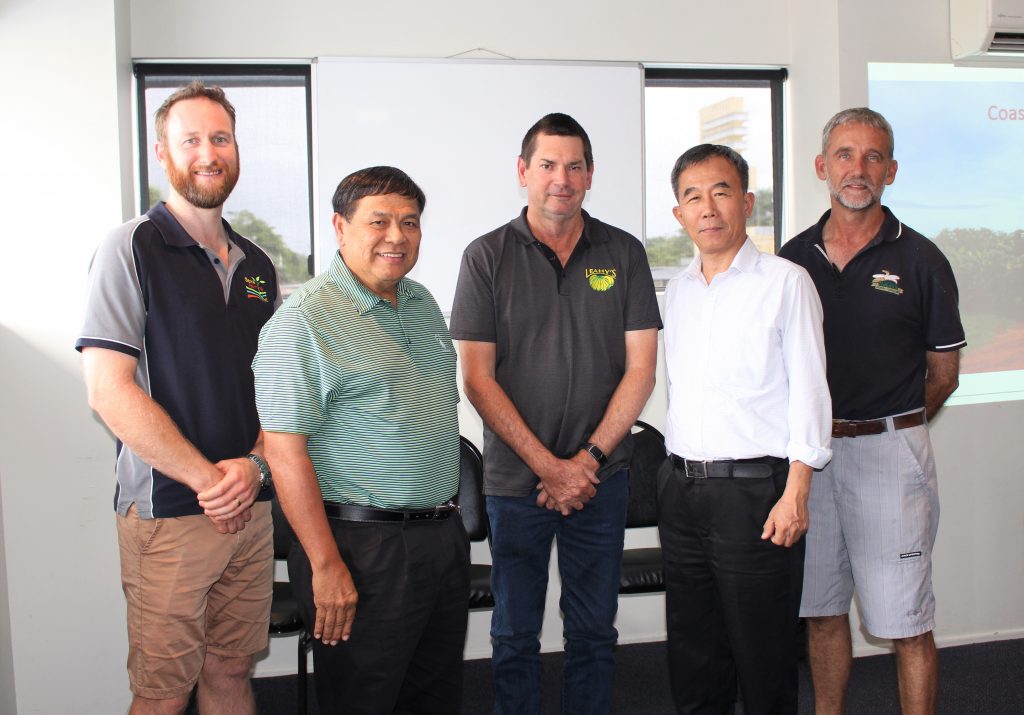By Rosie Godwin & Stewart Lindsay
In early February this year, Dr Chih-Ping Chao (Director) and Dr Gus Molina (consultant) from the Taiwanese Banana Research Institute (TBRI) met with a delegation from the Australian banana industry in north Queensland.

The aim of the visit was to discuss opportunities for research collaboration, Australian access to Cavendish germplasm developed by TBRI, the terms and conditions for on-farm, pre-commercial grower trials and future possibility to commercialize selected varieties.
Access to improved germplasm from overseas banana breeding programs is vital for the Australian industry to help combat diseases like Fusarium wilt TR4 since we do not have a breeding program of our own.
The Banana Varieties subcommittee has the responsibility to oversee access and the development of new varieties under the industry’s largest Hort Innovation levy-funded project, BA16001, Improved Plant Protection for the Banana Industry.
The Varieties subcommittee has developed a strategic import plan focused on dessert style bananas, particularly types familiar to consumers (AAA/AAB/ABB genomes), with resistance to Fusarium wilt Race 1 and TR4.
The subcommittee has also evaluated the potential of all global banana-breeding programs to collaborate with the Australian industry and TBRI was identified as one of the key partners for closer engagement and collaboration.
TBRI is of interest to the Australian industry because their selection program is focused solely on resistance to Fusarium wilt TR4 in Cavendish varieties.
The first report of Fusarium wilt of banana in Taiwan was in 1968 in the variety Pei Chao (their standard Cavendish variety), and spread rapidly to epidemic proportions by the mid-1970’s as limited biosecurity practices failed to contain the disease.
The development of commercial production of tissue cultured plants for clean planting material in the early 1980s also provided the opportunity to select for off-type plants with desirable characters such as Fusarium wilt resistance (somaclonal selection) in high inoculum screening trials.
Initial resistant selections showed very poor agronomic traits.
Over time, Cavendish selections with varying levels of resistance have been made, with a number of commercial selections released to the banana industry.
Each of these has some limitations in terms of production cycle or fruit quality.
New varieties being evaluated in Taiwan which are of interest to the Australian industry include an improved selection of Formosana—GCTCV 218-2.
It is around one month faster cycling, 30–40 cm shorter than standard Formosana, but with similar Fusarium wilt TR4 resistance and bunch size.
It also has less problem with maturity bronzing, thrips damage (Corky scab) and de-greening time during ripening.
TBRI has also started selecting for resistant selections of Williams rather than Pei Chao with some early selections getting to bunching stage in the field without developing disease symptoms.
Dr Chao and Dr Molina spent a day and a half in talks with the Australian delegation which included senior staff from DAF, Hort Innovation, ABGC representatives and banana growers.
Dr Chao and Dr Molina also had the opportunity to meet project scientists, visit Mission Beach Tissue Culture and chat informally with a group of Australian growers over dinner.
As a result of their visit, a Memorandum of Understanding between the Queensland Government and the Taiwanese government is currently being negotiated.
This will cement relationships between the two countries.
A Material Transfer Agreement is also being negotiated between the Queensland Government and TBRI to outline the terms and conditions for accessing germplasms as well as how it can be used for research and in limited scale grower trials.
Collaborative R&D activities involving variety selection and screening where the Australian banana industry is actively partnering with TBRI are also being developed.
We hope to obtain access to TR4 tolerant/resistant Cavendish varieties including the Improved Formosana and others yet to be determined.
TAIWANESE BANANA INDUSTRY
- Taiwan produces around 14000 ha of bananas and was once a significant exporter to the Japanese market. Now it supplies less than 1% of that market due to competition from the Philippines. This was caused by the loss of export arrangements and the impact of Fusarium wilt TR4.
- Production systems in Taiwan are mainly based on single cropping cycle due to the impacts of typhoons and TR4. Arable land is at a premium in Taiwan and most banana production occurs on one hectare plots.
- Eleven percent of the tissue cultured plantlets produced by the TBRI between 2011 and 2017 were Formosana, 33% were other improved TR4 tolerant varieties, and 46% were Pei-Chao (their Williams equivalent).
